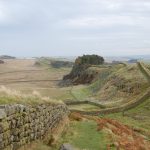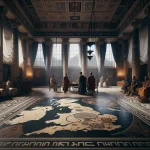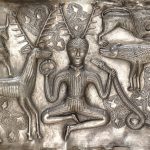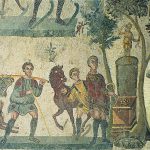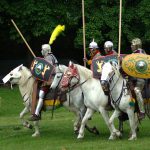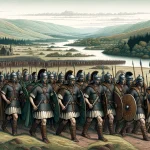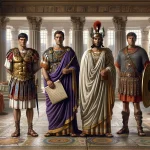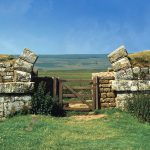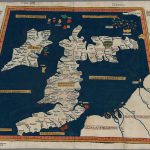Newstead (Trimontium) Roman Fort
Flavian Auxiliary Fort (AD 69–96)
Although nothing remains of the Newstead fort, dominated by the British hill-fort on Eildon Hill North, the site itself is commemorated by a large modern altar stone of granite. A circular walk punctuated by several information points with constructional paintings also help the visitor realise its past importance. A military amphitheatre excavated in the late-1990’s is marked by a circle of white-painted stones in a small hollow outside the northern defences and, overlooking the site from the disused railway embankment to the east, a reconstruction of the fort’s defensive rampart with an interval tower was in the process of being built during our visit.
The Newstead Forts
Although no legionary building inscriptions have been recovered from Newstead it is almost certain that the main fort of the complex was built by the Twentieth Legion Valeria Victrix, as they are mentioned on nearly all of the legible inscriptions recovered from the site.
There are at least two forts occupying the same site. The first fort was built during the first Roman forays into the Scottish Highlands, conducted by the intrepid governor Agricola , very likely during his 80AD campaign season. This Flavian fort has an atypical plan (vide supra), which appears to be purely Agricolan in design.
At Newstead, the best conditions for observation of the fort occur after fresh ploughing, when the beaten clay of the ramparts may be seen as a white soil mark, even from the North Eildon Hill. Both east and south annexes seem to have been defended everywhere by two ditches. …” (St. Joseph, 1958)
The second occupation took place during the Antonine period, when the fort was rebuilt on a more conservative plan, this time evidently to house a regiment of cavalry (vide sinistra). The garrison were presumably used to patrol the road far to the north and south, in order to maintain communications between the Legionary base at York and the newly-built Antonine Wall, between the Forth and the Clyde. There is a partition wall in this incarnation of the fort which apparently separated the stables and cavalry barracks in the northern half, from the infantry barrack-blocks in the southern half, which probably held a single legionary cohort. The interior buildings of the fort were apparently rebuilt in stone during a further construction phase, possibly during the Severan campaigns of the early third century.
Fort Timeline
The fort was constructed in multiple phases. Dr Simon Clarke of Bradford University has produced a logical sequence of building and destruction for the fort and its annexes. This was managed by combining evidence from the first excavations of James Curle (1905–1910) and Sir Ian Richmond (1947) with aerial photographs and modern search and rescue excavations of Bradford University (1987–1997)
- c.79-87AD: The earliest occupation of the site was the irregular Agricolan fort established c.80AD. It had a turf rampart on a cobble foundation with two ditches in front of it, overlapping each entrance. On the west side was an annexe which was also defended by a similar rampart and ditches arrangement.
- c.90-105AD: After a possible short abandonment of the fort the Romans were back, and building in strength. Old ditches were filled in and new defences constructed. This resulted in a colossal strengthening of the fort. The new turf rampart was built on a cobble base which measured 13.5m across and around 8.4m high. In front of this was a single ditch between 5 & 7m wide and 2 to 4m deep. New, well defended annexes appear on the south, east and probably north sides of the fort, inhabited by civilians and camp followers.
- c.105-137AD: Trimontium was deserted as the Roman occupiers retreated south of Hardrian’s Wall.
- c.137-139AD: Dr. Clarke suggests that evidence points to the possibility that the fort was reoccupied a few year prior to the 140AD advances into Caledonia by Emperor Antoninus Pius. If this is the case it stands that the fort would have been a formidable outpost beyond Hadrian’s Wall, with a civilian population within the annexes. Excavations and modern archaeology show the main entrance is now positioned through the southern annexe.[7]
- c.140-158AD: As the Roman presence pressed northwards and work began on the Antonine Wall (from 142AD), the role for Trimontium changed. It was reduced in size with the building of a 2m thick masonry wall through the main fort, though at the same time stone was used in the rebuilding. Manufacturing was becoming an important role for this newly purposed supply and logistics centre. Now behind the front line it is believed that the civilian population attached to the fort may have numbered some 2–3,000.
- c.160AD: Around this time the previous construction of the sub-dividing wall was removed as Trimontium’s role changed from supply & manufacture to a front line fort due in part to the abandonment of the Antonine Wall. Within the fort a long, narrow barrack block was constructed and evidence points to a large decrease in the civilian population surrounding the fort.
- c.160-184AD: As the civilian population surrounding and supporting the fort diminished further the land that housed the annexes returned to a more natural state. The military presence reduced further, with the barrack block now housing the remaining soldiers and their families. The evidence points to the fort being deserted some time around 180AD. It is unclear whether the remaining civilian population left at this time or remained, outside or even inside the fort. Evidence does point to the potential use of early 3rd and late 4th century coins in the area (coins have been found to the south and to the west of Newstead village). Were the local population still engaged in a Romanised trade and economic pattern of behaviour?
The Fortlet on Red Rig
This fortlet measures 140 x 170 feet (43 x 52 m) and covers an area of about ½ acre (0.22 ha).
Evidence of the Roman Military Diet at Newstead
During excavations over the years at Trimontium a number of animal bones have been uncovered, including those of domesticated Ox, Sheep, Goat and Pig, game such as Red Deer, Roe Deer, Hare and Elk, also Fox, Badger and Vole; the latter three animals very likely being hunted and killed for sport and as a means of pest control. The remains of both domestic and wild fowl included Chicken, Duck, Crane and Raven.
The Dateable Pottery Evidence
The stamps of several Flavian and Flavian-Trajanic potters have been uncovered at Trimontium; there are six of Vitalis, three of Calvus and Frontinus, two each of Iucundus, Cotto, Sabinus and Silvanus, and single examples of Coius, Cosius Rufinus, Crispus, Crucuro, Dago, Ego, Firmo, Iullinus, Q. Julius Habilis, Masculus, Memor, Primus, Rufinus, Rufus, Secundus and Severus. The Flavian and Flavian-Trajanic South Gaulish decorated wares consisted of thirty-nine sherds of Form 37 and fourteen of Form 29.
The Newstead site has also yielded 126 potter’s stamps dating to the Antonine period.
The Garrison Units
RIB 2125 - Altar dedicated to an unknown god or goddess
… Gaius Arrius Domitianus, centurion of the Twentieth Legion Valeria Victrix, gladly, willingly, and deservedly fulfilled his vow.
𐆛 L[... ...]
V S L [ ]
No commentary.
Ala Vocontiorum – The Wing of Vocontii
RIB 2121 - Altar dedicated to the Goddesses of the Parade-ground
Sacred to the Goddesses of the Parade-ground: Aelius Marcus, decurion of the Augustan Cavalry Regiment of Vocontians, gladly, willingly, and deservedly fulfilled his vow.
SACRVM AEL
MARCVS
DEC ALAE AVG
VOCONTIO
V S L L M
Richmond (PSAS 84 (1949-50) 21) assigns this unit to the occupation of A.D. 142-55, in association with a detachment of legio XX.
This regiment is mentioned on a single altarstone at Newstead, which remains the only inecription on stone attesting the presence of this unit in Britain; the text is reproduced above. They were a five-hundred strong cavalry unit recruited from amongst the Vocontii tribe of Gallia Narbonensis, who inhabited the Orange district of southern France on the eastern banks of the Rhône. It is very likely that this regiment shared the fort with a legionary cohort, the cavalry occupying the northern part of the fort and the infantry housed in the southern half.
RIB 2120 - Altar dedicated to Apollo
To the god Apollo Lucius Maximius Gaetulicus, centurion of the legion, (set this up).
APOLLINI
L MAXIMIVS
GAETVLICVS 𐆛
LEG
Gaetulicus belonged to the Twentieth Legion, see RIB 1725 (Great Chesters).
Gaius Arrius Domitianus
As has already been mentioned, four out of the six altars recovered from the site were all dedicated by the same centurion of the Twentieth Legion, Gaius Arrius Domitianus (vide RIB 2125 supra, et ceteri infra).
- The terminating formula on all these altars is the same as RIB 2125 shown above.
The commander of a legionary cohort would usually be a military tribune, but this seems not to have been the case at Trimontium. The placing of these altars, particularly the one dedicated to Jupiter Optimus Maximus, would normally be the responsibility of the commander of the unit, and we must therefore assume that Domitianus was stationed at Newstead in this capacity. The responsibility of commanding this crucial site guarding the communication route to the south would not have fallen to an ordinary centurion, but one with many years experience – and a decent amount of money, stone inscriptions don’t come cheap – probably not a primipilus,¹ who was the highest-ranked centurion in a legion, but very likely a centurion in the first cohort, the cream of the regiment.
- Literally ‘first spear’, the most experienced soldier in the entire regiment; equivalent to the modern day ‘top gun’.
Classical references to Trimontium / Trimontivm
The Roman name of the Newstead fort is known from two of the main classical geographical sources. In Geography of Ptolemy the name is listed as Trimontium, the last of four towns attributed to the Selgovae tribe of the Scottish Borders region; the other three towns mentioned by Ptolemy, Carbantorigum, Uxellum and Corda, are all unidentified. The fort is also listed as Trimuntium in the Ravenna Cosmology (R&C#183), where it appears between the unidentified station Venutio and the entry for Habitancum (Risingham, Northumberland). The name of this fort also appears as Trimonti[o] on a Roman milestone near the Firth of Forth at Cramond in Lothian (vide RIB 2313).
The Roman name is a simple compound of two Latin words, the prefix tri- indicates three of something, coupled with the ending montium or muntium which means ‘of the mountains’, the name can be readily translated as ‘the place of the three mountains’, which may themselves be identified as the Eildon Hills.
References for Trimontivm
- Air Reconnaissance of North Britain by J.K. St. Joseph in J.R.S. xli (1951) p.57;
- The Roman Occupation of South-Western Scotland by the Glasgow Archaeol. Soc., ed. S.N. Miller (1952) p.206;
- Air Reconnaissance in Britain, 1955-7 by J.K. St. Joseph in J.R.S. xlviii (1958) pp.87/8;
- The Roman Inscriptions of Britain by R.G. Collingwood and R.P. Wright (Oxford 1965);
- The Roman Military Diet by R.W. Davies in Britannia ii (1971) pp.122-142;
- The Roman Occupations of Scotland by B.R. Hartley in Britannia iii (1972) pp.1-55.
Map References for Trimontivm
NGRef: NT5734 OSMap: LR73/74
Roman Roads near Trimontivm
SE (12) to Cappvck (Borders) Dere Street: NW (13.5) to Channelkirk NNW (27) to Elginhavgh (Lothian) N (4) to Kedslie Probable Road: WNW (26) to Lyne (Borders) Dere Street: SE (4) to Maxton Possible Military Road: SW (12) to Oakwood (Borders) Dere Street: NNW (13) to Oxton (Borders) Dere Street: SE (3) to St Boswells Dere Street: N (7) to St Leonards S (33) to Raebvrnfoot
Sites near Newstead (Trimontium) Roman Fort
- Newstead Temporary Camp 4 (1 km)
Marching or Temporary Camp - Newstead (Trimontium) Temporary Camps 1, 2 and 3 (1 km)
Marching or Temporary Camp - Newstead Temporary Camp 5 (1 km)
Marching or Temporary Camp - Newstead (Trimontium) Amphitheatre (1 km)
Amphitheatre - Drygrange Temporary Camp (1 km)
Marching or Temporary Camp - Eildon Hill (2 km)
Iron Age Hillfort and Signal Station - Mertoun Bridge Temporary Camps (St. Boswells) (5 km)
Marching or Temporary Camp - Kedslie Temporary Camp (6 km)
Marching or Temporary Camp - Maxton Camp (6 km)
Marching or Temporary Camp - Milrighall Temporary Camp (8 km)
Marching or Temporary Camp
